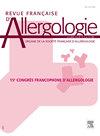Assessing allergenicity of urban parks: Ordu City
IF 0.3
4区 医学
引用次数: 0
Abstract
Higher average temperatures due to climate change tend to change the spatial and temporal distribution of pollens. The study area was conducted in the Urban Park areas of Ordu Province, where urban people spend the most time. In the last decade, various allergenicity indices such as Specific Allergenicity Index (SAI) and Urban Green Zone Allergenicity Index (IUGZA) have been proposed to control hypoallergenicity in urban areas. The study aimed to warn allergic individuals about the risk posed by pollens and evaluate the allergenicity of existing urban vegetation. Specific Allergenicity Index (SAI) and Urban Green Zone Allergenicity Indexes (IUGZA = 0.208) of 25 plant species spread in urban park areas were calculated. To determine these indices, life cycle, overlap-abundance values, height, pollination time, pollination process, allergenicity potential, and cross-reactivity values of the species were determined. Among the species, the species with the highest allergenic effect, i.e. both abundance and allergenic potential, is Corylus avellana var avellana. In terms of allergenic potential value (VPA), it is seen that C. avellana var. avellana, Alnus glutinosa, Cupressus sempervirens, Olea europae, Salix spp. and Acer spp. are the most effective species on the axes. The abundance of the species (0.802) was the factor that made the allergenic factors most effective. Determination of the urban allergenicity index of Ordu province to determine the ecological driving forces of the distribution of ecosystems is important in estimating the allergenicity index of urban green areas and in selecting the right species to minimize the allergenic in parks.
城市公园致敏性评估:奥尔都市
气候变化导致的平均气温升高往往会改变花粉的时空分布。研究区域是在Ordu省的城市公园区域进行的,那里是城市居民花费最多时间的地方。近十年来,人们提出了各种过敏原指数,如特异性过敏原指数(SAI)和城市绿区过敏原指数(IUGZA),以控制城市地区的低过敏原性。本研究旨在警示过敏个体花粉的风险,并评估现有城市植被的致敏性。计算了分布在城市公园区域的25种植物的特异性致敏性指数(SAI)和城市绿区致敏性指数(IUGZA = 0.208)。为了确定这些指标,测定了物种的生命周期、重叠丰度值、高度、授粉时间、授粉过程、致敏潜力和交叉反应性值。其中,致敏效应(即丰度和致敏潜力)最高的物种是Corylus avellana var avellana。从致敏潜值(VPA)来看,在轴上最有效的树种是黄樟(C. avellana var. avellana)、桤木(Alnus glutinosa)、柏树(perpressus sempervirens)、油橄榄(Olea europae)、柳树(Salix)和槭(Acer)。物种丰度(0.802)是使致敏因子最有效的因素。确定奥尔都省城市变应原指数,确定生态系统分布的生态驱动力,对于估算城市绿地的变应原指数和选择合适的物种以减少公园的变应原具有重要意义。
本文章由计算机程序翻译,如有差异,请以英文原文为准。
求助全文
约1分钟内获得全文
求助全文
来源期刊

Revue Francaise d Allergologie
Medicine-Immunology and Allergy
自引率
33.30%
发文量
349
期刊介绍:
La Revue Française d''Allergologie : un véritable forum pour faire connaître des travaux originaux et permettre la diffusion de l''information auprès de toutes les spécialités concernées par les pathologies allergiques. La Revue Française d''Allergologie (8 numéros par an) est au carrefour de nombreuses spécialités - dermatologie, pédiatrie, ORL, pneumologie, ophtalmologie, médecine interne - qui, toutes, ont à traiter des maladies allergiques. Les symptômes des allergies fondés sur des mécanismes communs sont le plus souvent associés et se succèdent chez un même patient. En forte progression depuis 20 ans, les maladies allergiques sont dans l''attente de perfectionnements et d''avancées thérapeutiques qui permettront aux nombreux patients qui en sont atteints de mieux vivre avec leurs allergies. La Revue Française d''Allergologie se veut donc un véritable forum de discussions et d''échanges entre tous les spécialistes confrontés aux pathologies
 求助内容:
求助内容: 应助结果提醒方式:
应助结果提醒方式:


